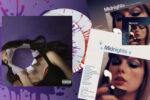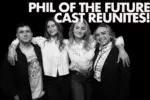I’ll admit it: Despite the intense media hype, Instagram and Twitter attention and people quite literally blasting the soundtrack in the halls of my high school, my first real experience with Lin-Manuel Miranda’s musical theater masterpiece “Hamilton” occurred this year.
To be entirely fair, “Dear Theodosia” had found its way onto my playlist the year before, and I did know the general premise of the musical: The Founding Fathers debate the best way to organize a government in a series of rap battles, the British king is hilarious and Hamilton gets shot at the end. But I had never listened to the soundtrack all the way through and certainly never watched “Hamilton” until it hit Disney’s streaming service, Disney+, in July.
Although I came to “Hamilton” approximately four years late, my enthusiasm for the show felt completely fresh. As I write, I have watched the musical three times in full and listened to the soundtrack many more. For at least a week, Miranda’s lyrics permeated my every waking thought. Even my journal entries were interspersed with the occasional “Why do you write like you’re running out of time?” or “Tomorrow there’ll be more of us.” I wish I was exaggerating.
As my infatuation eased and I began to reflect, though, I realized that my experience with “Hamilton” was likely different than it would have been had I watched and obsessed over the show when it first came out in 2015. Thus, I present to you: the pros and cons of being a second wave “Hamilton” fan.
1. Pro: I got to see the show with the original cast
Undoubtedly, one of the most appealing aspects of the Disney+ streaming experience is the opportunity to witness Miranda, Daveed Diggs, Phillipa Soo, Leslie Odom Jr., Renée Elise Goldsberry, Christopher Jackson, Jonathan Groff and Anthony Ramos in all their glory. Though I am sure the off-Broadway casts performed with similar chemistry and passion, I imagine that none can quite compare to the original, especially with the creator of the show, Miranda, in the starring role.
2. Pro: The television viewing experience was as easy as it gets
I watched “Hamilton” on my own schedule, and, courtesy of Disney+, I was afforded a front row seat. Not only did I get to watch the show from the comfort of my own home — a location that has become synonymous with safety since the onset of the COVID-19 pandemic — I also had the unique luxury of watching the musical for the first time with subtitles. As someone who was entirely new to the music and lyrics of “Hamilton,” I would have been completely lost without the guidance of the tiny white words at the bottom of the screen.
I will say, though, that my second and third viewings of “Hamilton” were significantly more enjoyable, given that I could focus on the actors’ faces and movements on the stage rather than attempting to read along with every song. And it is not lost on me that the second and third viewings were yet another luxury of being a second wave “Hamilton” aficionado.
3. Pro: I had the chance to have a personal experience with the show
I watched the musical long enough after the obsession with “Hamilton” gripped the first wave of musical theatergoers that I was not annoyed or overwhelmed by the reactions of my peers and social media channels, nor was I influenced by what anybody else thought of the show. That being said, perhaps something was lost in my extremely convenient living room experience of “Hamilton,” for theater is meant to be enjoyed in a group setting. Perhaps at some point I will have the opportunity to watch the show live and make a more thorough comparison between the two experiences, but for now, the highly convenient and oddly private Disney+ version is all I have to work with.
4. Con: I had serious expectations going in
As a 2020 viewer, I had a pretty solid concept of what to expect from “Hamilton.” Even though I knew only the loose plot points, I had heard all the rave reviews and watched friend after friend succumb to the point of obsession with the soundtrack. I was expecting something spectacular. Frankly, I was not disappointed, but I did have to consciously suspend my ideas of what the show would be like to genuinely enjoy it on the first watch.
5. Con: I missed out on the live energy of the cast and the audience
Theater is intended to be performed live, in real time, in front of an audience. The show may change slightly from night to night depending on the interactions between the actors and the crowd, and the reactions of people around you in the theater contribute to making a theatrical experience meaningful. Though the videographers in charge of shooting the Disney+ version of “Hamilton” were clearly dedicated to capturing the actors at different angles, including close-ups and wide shots of the stage, nothing can quite match the excitement and anticipation of attending a theatrical production in person.
6. And one last neutral observation on viewing “Hamilton” in 2020: It is highly relevant to the current social and political moment
“Hamilton” is quite literally about a revolution in which the disenfranchised rise up to overthrow their oppressors; though one could arguably draw parallels between the United States’ secession from Great Britain and any other historical revolution, I could not help but notice the similarities between the Founding Fathers’ goals and the goals of the Black Lives Matter movement.
The show champions tireless work and community building to come together as a nation and reject the oppressive structures put in place by an oppressive regime. For the characters in “Hamilton,” the final straw was the Stamp Act. For the many Americans who have rallied behind the Black Lives Matter movement, especially Black Americans, the final straw was the police murder of George Floyd. In both cases, the underlying thread of the movement is the narrative of the people using their voices to reclaim power.
It was also interesting to view “Hamilton” in light of the Black Lives Matter movement because of the way that the show seems to glorify historical figures, notably George Washington and Thomas Jefferson, who, despite their abolitionist ideologies, both owned enslaved people and undoubtedly benefitted economically from the labor of enslaved people, given their status as wealthy white men. Jefferson’s hero status has also come under public scrutiny for his relationship with Sally Hemings, an enslaved woman with whom he had several children.
However, I would be remiss if I did not also note that “Hamilton” showcases a clear commitment to uplifting the voices of people of color and features a cast of almost entirely Black, Latinx and Asian people playing white historical figures. The show clearly aims to tell a different kind of story from the one that most students learn in history class.
And “Hamilton” in no way pretends to be a comprehensive biography of any of its characters, not even of Alexander Hamilton himself — but there is certainly reason to worry that rather than celebrating Diggs’ Jefferson, for example, viewers will glorify the historical figure. In this sense, “Hamilton” exists in tension between uplifting the voices of people of color in a traditionally exclusionary theater setting and paying homage to historical figures that were almost certainly very racist, all while promoting a narrative of revolution. Honestly, I am still grappling with this 2020 complication to the subject matter of “Hamilton.”
In sum, despite the fact that my viewing of “Hamilton” was a non-traditional theater experience lacking in the magic of live performance, watching the musical four years after the first wave of obsession hit was in many ways convenient and thought provoking. If you haven’t seen “Hamilton” on Disney+ yet, what are you waiting for? Borrow your friend’s subscription, and hop on the second wave.

















